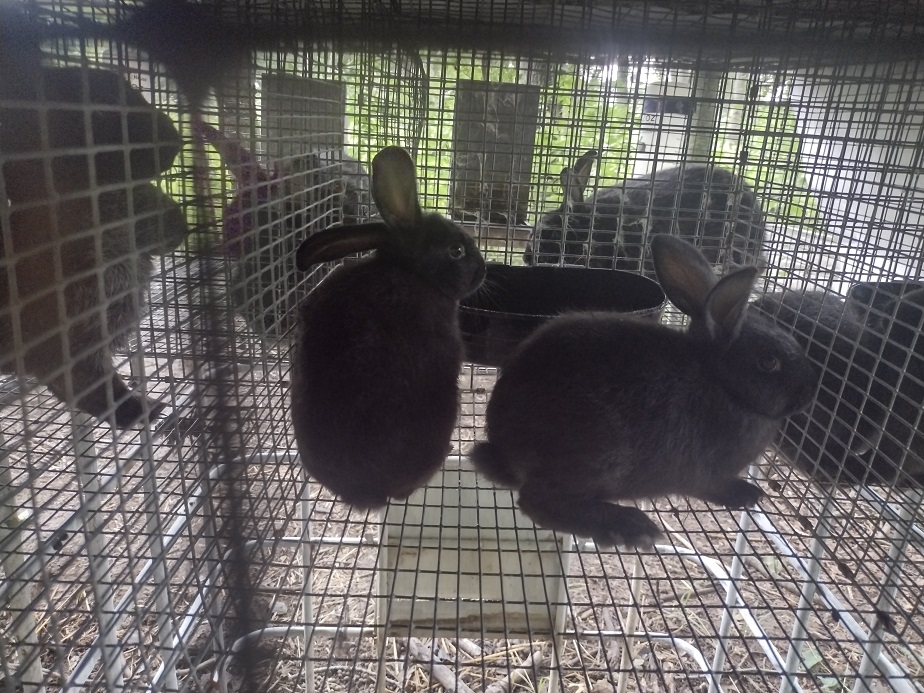We strive to be as self-sufficient as possible but that’s hard with animals. It can be done, and in a practical way. Some animals are far more practical than others when it comes to putting meat on the table.
Rabbits
Rabbits are perhaps the best animals for self-sufficiency. They are the easiest to feed, they are highly productive, and they are easily contained. Rabbits are more practical and economical in most instances than other livestock.
Probably the biggest factor for rabbits is their feed requirements. They can do very well on a diet of only green forage. Breeders and growing young can gain good weight and stay well-nourished on a diet of tree leaves, grass, and weeds like chickory and burdock. In fact, that’s a decent diet mix.
Green leafy fodder grows pretty much everywhere in the world. When nature grows animal feed, it’s pretty smart to take advantage of it. I raised a lot of rabbits on a diet of wild grass, chickory, clover, and burdock leaf. That’s the bulk of the forage that grows wild here.
I’ve even known people who fed rabbits grass clippings from their lawn, supplemented with a little sunflower seed as additional starch and protein. Being able to use what’s around you is the key to self-sufficiency. As much as practical, use what nature is trying to give you.
You can easily grow a high-energy rabbit feed for higher growth. Sugarbeet, mangel, sunflower, corn, and jerusalem artichoke are great options for feed that can be fed to rabbits to boost up the calories for improved growth, particularly in cold weather. I’ve found that sort of feeds to help nursing mothers too.
Rabbits can be housed in simple, floorless cages directly on the ground, or in elevated wire cages. My first rabbit cage was made of pallets, reclaimed chicken wire, and half of an old-broken door. It worked well for them. Now I use all-wire cages. I have found that used rabbit cages are cheap and easy to find.
The fact that they can be housed so cheaply and simply is the second reason why I like them so much. Simple wood and wire keeps them safe and contained. Keep them out of the wind and under some sort of rain cover and that’s all they need.
Rabbits are very productive. A not-too-intensive breeding schedule averages around 32 bunnies per year from each breeding female. That’s 8 bunnies per litter, 4 times a year. Each of our breeding does produce about 80 pounds of meat per year for our family. 6 does can produce as much meat as a butcher-ready steer, about 480 pounds, and on half as much feed.
Rabbits are the most economical, most productive, and simplest to care for of all common livestock options. Any rabbit can be raised for meat, but commercial-type rabbits tend to be a little more efficient.
We are really focusing on rabbits this year and want to be mostly or completely feed-sufficient for them. We want to maintain 10 breeding does and 2 bucks. For the record, that will take about 4,800 pounds of pelleted rabbit feed. We’re planning on growing our own feed.
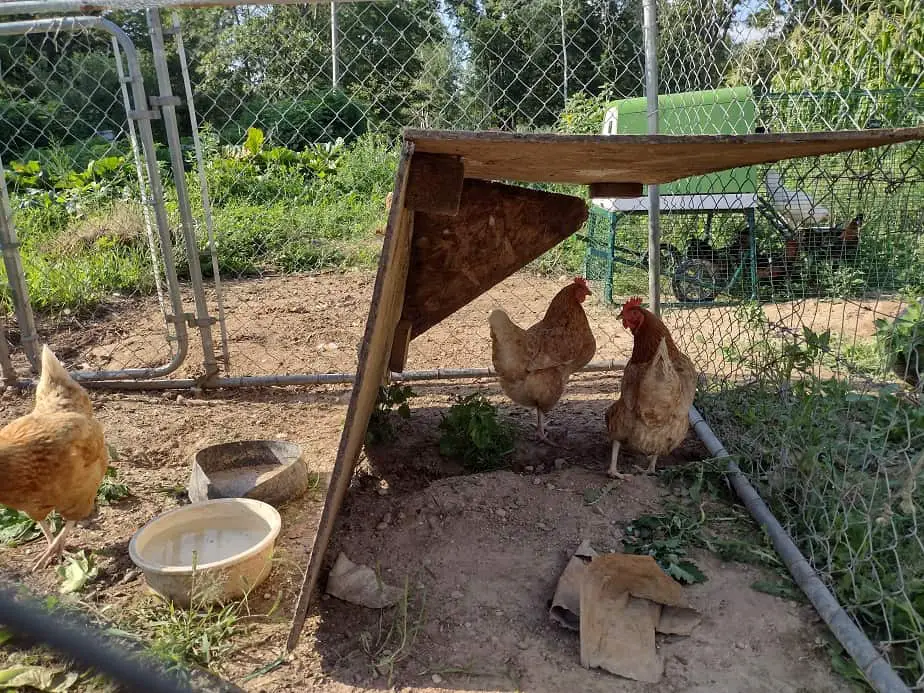
Chickens
Chickens are the staple of self-reliance world over. They are easy to keep contained, easy to keep healthy, and easy to keep happy. Chickens are great foragers and will find much of their own feed if you let them. Chickens are hardy, reliable, and don’t require expensive housing structures.
Chickens were the first animal I brought onto our homestead. They were completely free-ranged since I didn’t have a coop at the time. Without any feed, a dozen free-range chickens can give you 6 eggs a day. It was pretty helpful at the time.
Chickens should have some shelter to help deal with the stress of wind, rain, and cold weather. It does help a lot. A simple coop can be little more than a lean-to or a few pallets and a tarp. It doesn’t have to cost much. Laying hens like a clean little nesting spot with straw, leaves or grass.
Chickens are fairly productive. One broody hen can hatch 15 or more healthy chicks in the summer. Some breeds have the broodiness bred out of them but almost any hen that does end up brooding will make a good mother. If you have a rooster in the flock and a hen goes broody, let her hatch those eggs.
There are two issues with chickens. Firstly they are very prone to predation. Any chickens running through the yard can be picked off by coyotes, foxes, hawks, or the neighbor’s dog. At night, we have had a lot of trouble with opossums and raccoons. Raccoons really love trying to get into chicken coops.
I’ve never had a raccoon try and get into my rabbit cages, just the chicken coop. No idea why, but we’ve lost a lot of good chickens to raccoons. It’s an issue. you have to keep the coop and nesting area secured.
The second issue is that chickens need a lot of protein. A chicken’s diet should include vegetation, carbohydrates, fat, and meat. That meat can be from bugs and insects, or it can be from food scraps or butcher waste. Chickens are omnivores and really need an omnivorous diet.
That’s harder to source than grass. Still, The easy keeping nature and productivity of chickens puts them high on this list. Well-fed young chickens will lay 5 eggs a week, produce some nice manure for the garden, and provide a nice chicken stew when she’s no longer laying well in a few years.
Laying chickens need extra calcium to keep up egg production. You can supplement that largely through crushing eggshells and putting them in a feed bowl for them. They tend to really go for it. Other than that, I like to give my chickens alfalfa for the calcium content (we’re starting to grow our own).
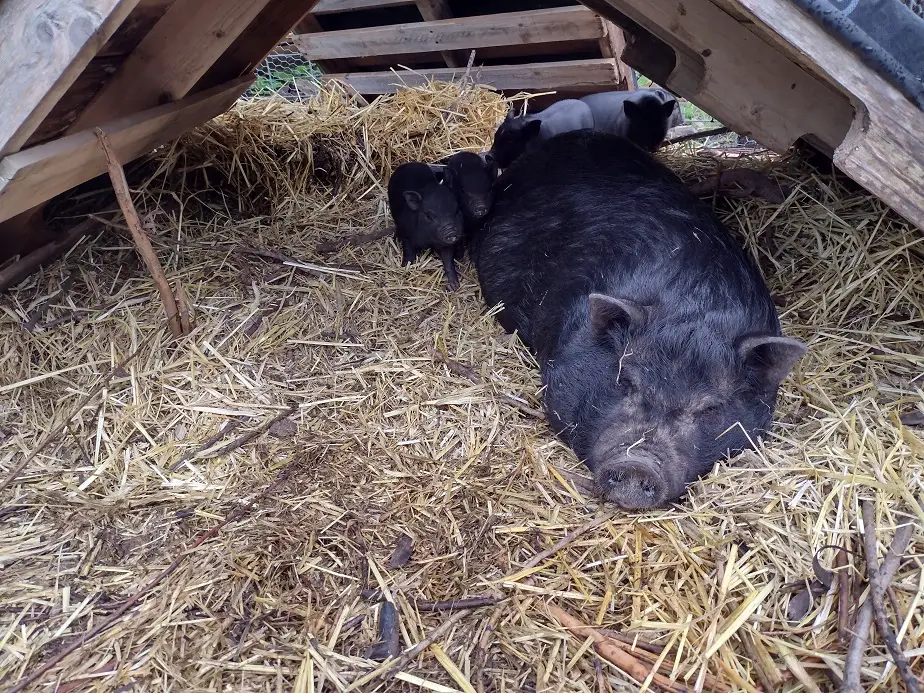
Small-Breed Pigs
Pigs are incredibly efficient animals, having an almost unbeatable feed conversion ratio between 3:1 and 4:1. Pigs are very hardy, decent foragers, and are opportunistic omnivores, making use of any available feed source. Pigs do best on a diet containing vegetation, grains, and some added protein.
Small-Breed pigs are more suited to a homestead operation. Some common breeds are the Potbelly, Kunekune, Idaho Pasture Pig, and American Gunie Hog. These pigs all average approximately 40-70 pounds at 6 months (butcher age) and 150 to 250 pounds as adults.
Commercial breed pigs grow to 250 pounds at 6 months and can reach 700-900 pounds as mature breeders. It’s the sheer size of the big ones that make them impractical and hard to handle. The smaller pigs are a lot easier to contain and maintain. Pigs of all breeds butcher out at 50 percent of live weight.
Heritage breed pigs do better on a less commercial diet (something other than commercial hog feed), such as fermented grains or a vegetation-heavy diet. They develop a richer tasting meat, more fat marbling, and have better mothering instincts.
My favorite breed is the Potbelly. They produce a beautiful, delicious pork and do well on a pasture-heavy diet. It’s also a simpler job to butcher a 50-pound potbelly (25 pounds of pork) compared to a 200 or 300-pound comercial hog.
I find our pigs to be within 10 percent of a standard feed-to-meat conversion and the fact that they are easier to handle and do better on traditional feedstuffs well make up for that.
I love pigs because they are so darn productive and grow fast. Pigs have litters between 6 and 15, depending on age, genetics, and breed. Smaller breeds like the Kunekune and Potbelly have litters averaging 8 or 9. Pigs can have 2 healthy litters a year.
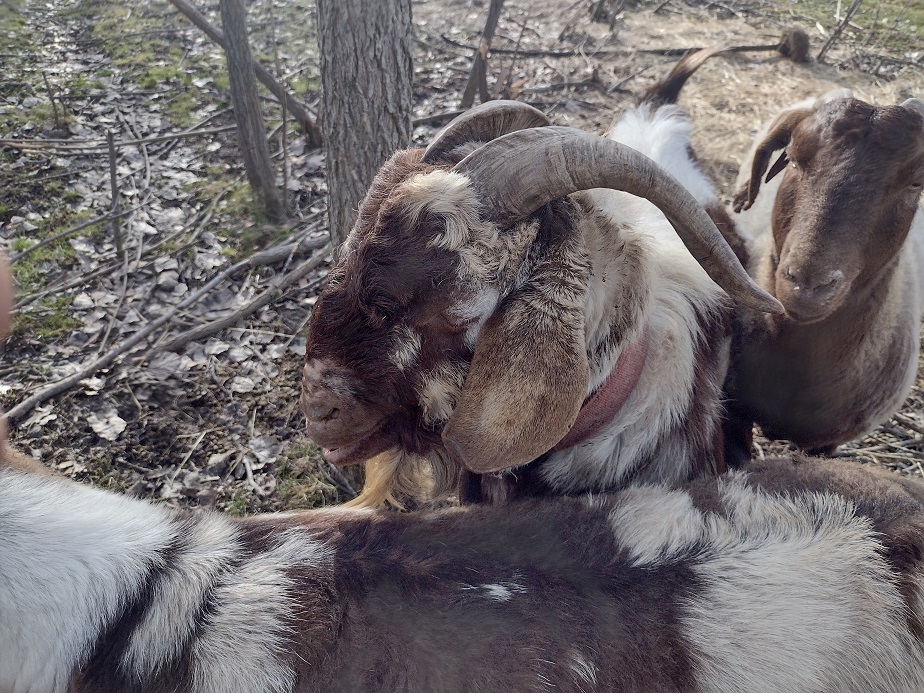
Goats
Goats are more hardy and more efficient than cattle. They are definitely smaller, but gain similarly on less feed, and have slightly more young per year. Goats produce milk with more protein and milkfat than cows. Goats are the most efficient ruminant for producing meat.
Goats are usually slaughtered at 3 or 6 months. Meat breed goats tend to yield 30 percent of live weight, and skinnier breeds yield closer to 20 percent. They have a low yield as a percentage, but feed to meat ratio makes them equal to cows.
Goats are fairly simple to handle and contain. They are less prone to sickness than larger ruminants and make themselves at home in a wider selection of environments. Across Europe, Africa, and North America, goats are the animal of choice for nomads and lower-class farmers.
Simple pallet shelters are more than adequate for goats. They do well on a pasture diet ranging from grassy to brushy fodder. They handle confinement well too. A small pen is fine for goats as long as you keep it clean and provide enough feed.
Goats are probably the most adaptable of all livestock. They don’t need additional protein like pigs or chickens do. Green vegetation alone is often quite sufficient. As milk producers, they are as efficient as a traditional milk cow and the milk is more digestible for humans than cows milk.
The reason I didn’t get goats is because they are less productive. They can give birth twice a year and usually have 1 or 2 young each time. They just don’t reproduce like some other animals. That means keeping about 5 females and a male to raise enough meat goats each year.
A 100-pound goat only yields 30 to 35 pounds of meat. I don’t have enough pasture space to grow feed for that many animals. A high reproduction rate makes animals much, much more efficient.
Sheep
Sheep are easy keeping, as productive as goats, and generally well mannered. But, having single stomachs, they need better quality pasture than cows or goats. On nothing but grass, sheep are said to gain better than other animals. Sheep’s skittish and gentle nature makes them easy to contain.
Again, sheep only have up to 4 young a year and yield about as much meat as a goat. They’re not very fertile compared to rabbits, pigs, or chickens. Both sheep and goats are more practical if you have a good quality pasture for them and aren’t buying feed.
You’ll notice one of the big points I keep mentioning is containment. It’s a big deal. Animals that are hard to contain either due to size or temperament are a horrible experience and present a heavy workload. Larger animals are harder to contain. Smaller animals are both more efficient and easier.
To be self-reliant, we’re looking at the options of keeping breeding stock and producing our own animals. That’s the only feasible way to procure and raise meat animals in any fiscal manner, and yes, it’s cheaper.
Pigs for example, like to get their snout under things and lift up. Pigs have a tremendous amount of torque for their size. A large pig will shred a hog fence if it wants to. That’s why very few people who raise pigs keep breeding adults. They can’t handle an 800-pound animal with the power of a small forklift.
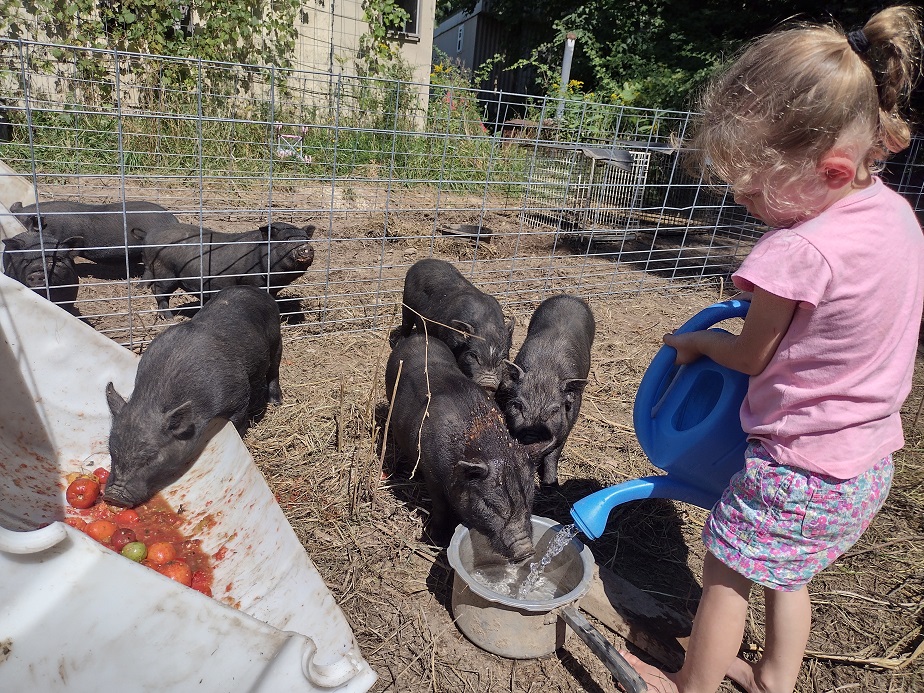
Which Animal is Best for You?
Consider your land and what it does. If you have a nice, thick growing pasture of grass and leafy greens, well that’s feed for all grazing or browsing animals. Land with a lot of shrub or brush growth is best for goats. If you have tillable soil, could you grow any feed items? What feed items are cheap locally?
Around here, we have a lot of orchards. We can get great prices on damaged apples which are good for all animals as a source of energy and fiber. We have access to produce from the farmer’s market. We use that to supplement our animals’ diets in the summer.
I found a farmer down the road who sells last year’s corn and oats at half price. It works great as a fermented feed for pigs and chickens. Fermented grain actually gains a lot of protein (including lysine) and is near a complete diet for both animals.
Sunflower, corn, and jerusalem artichokes can be grown fairly well and in most soil types. Those together would be a fine diet for pigs. Most people can hardly imagine growing their own pig feed. It’d not too hard either. Planting 1/4 acre of grain and beans can feed 2 litters of small-breed pigs.
If you have to buy commercial animal feed, your operation is not going to be self-sufficient of very frugal. Feed is by far the most expensive part of raising animals. The big farms can manage it by operating in huge volumes and using a lot of automation. We don’t have that option.
Look around your land and investigate your local options. Toss in a bit of creativity and determine just what you can do to become and maintain some level of self-sufficiency. If you have an questions, feel free to use the comment section below.
Related Articles:

